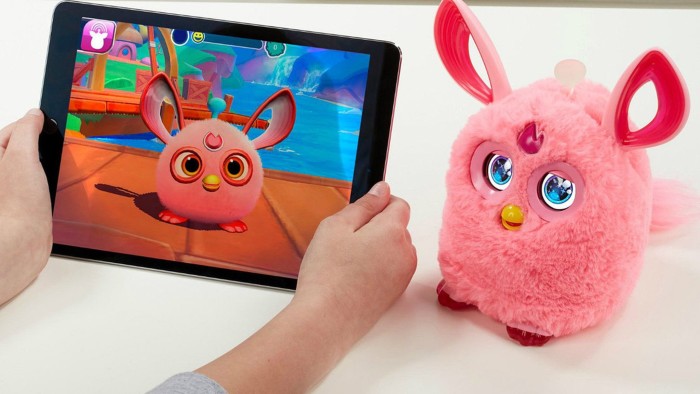Parents turn entrepreneurial to make Christmas gifts

Roula Khalaf, Editor of the FT, selects her favourite stories in this weekly newsletter.
The robot dog still makes me cross. We spent an exorbitant sum on it last Christmas, my son played with it for about three hours and since then it has been gathering dust. It is too depressing to calculate the cost per hour of play.
Another Christmas tech failure was the kid-friendly digital camera that drained AA batteries at an alarming rate. It has not been used since the toddler filled the memory card with 734 blurry pictures of her socks, which no one can be bothered to look through or delete.
I am not the only one who struggles with tech Christmas presents for children. “Gadgets don’t really get used,” sighs Maria Little, a parenting coach and mother of four. “They play with it for a week then forget about it.”
Despite tech toys getting plenty of column inches in newspaper Christmas-gift wish lists, sales of technology-based toys have not dominated the charts of best-sellers.
“Over the last couple of years there has been a trend for connected toys and we thought there would be a big rise in their sales,” says Frédérique Tutt, global toy industry analyst at market researcher NPD Group. “But they still account for less than 1 per cent of all toy sales. It is very niche.”
A new version of the 1998 electronic pet, Furby, complete with a Bluetooth connection and app, is at the top of NPD’s best-selling toy list, but most are old-fashioned games, dolls and Lego sets, says Ms Tutt.
There is, however, a growing group of parents-turned-entrepreneurs who are trying to create better tech toys. One is Bethany Koby, who founded toy company Technology Will Save Us after becoming frustrated with the tech toys available for her son.
“Tech toys don’t really engage kids in a productive, participative range of experiences,” she says. “They don’t keep up with the pace of kids.”
Her company sells, among other things, conductive play dough, that children can roll out to make electric circuits. Ms Koby believes that toys which allow children to build physical things will keep them engaged for longer.
An increasing number of toys combine the physical and digital, teaching children the basics of coding and encouraging them to take an interest in Stem (science, technology, engineering and maths) subjects.
Sharmi Albrechtsen’s failure to find educational but fun toys for her daughter led to the launch of SmartGurlz, Barbie-like fashion dolls that ride on mini-robots controlled through an app. The app teaches the basics of coding as users program the robots to move around.
“First, people were developing apps for children, now they are looking at ways to make things more concrete for a child, using physical things,” says Reyne Rice, a toy trends expert.
Making things more concrete and physical is also a concern for parents of older children, who fear losing their teenagers into a separate world of YouTube videos and instant messaging.
A study by research group Common Sense Media found that American teenagers spend on average about nine hours a day using electronic media, including watching TV, playing games and using social media.
Passive use of technology is a core concern for parents of older children, says Ms Little. She surveyed more than 180 parents while conducting market research for a new app. “Most parents with children under eight were looking for an app that limited screen time. Those with children over eight wanted something that engaged kids in normal activities. Their biggest fear was their kids becoming too passive and losing their creativity,” she says.
It is a reasonable fear. The Common Sense Media study found that US teens spent just 3 per cent of their time on electronic media on creative content, such as composing music, writing blogs or making artwork. About a third of parents of 12 to 15-year-olds surveyed by Ofcom, the UK communications regulator, said that their child’s screen time gets in the way of family activities.
“I feel like a bad parent when my daughters are just sitting there watching YouTube,” Ms Little says. “Even if they are watching something like gymnastics, I am thinking: ‘Why don’t you go and do it yourself rather than just watch it?’ ”
Her response was to develop a video app for sports teachers and students called ChallengeU, which brings together social media and children’s real-world activities. Sports clubs, for example, could post video tutorials and physical challenges that encourage children to upload their own activity videos.
“My son plays football but he is not keen on practising his skills,” says Ms Little. However, filming himself doing a keepy-uppy challenge and posting it on the site is likely to keep him interested. Other challenges on the app, which is still at the early stages of development, could include baking, reading, singing, drawing and dancing, says Ms Little.
One tech toy trying to pull older children back into the physical world is Happy Atoms, created by Jesse Schell and initially financed through a crowdfunding programme this year. Though it has an app, it mainly consists of physical rods and balls representing atoms that can be stuck to each other with magnets to make molecules. It is a hands-on way to show children how chemistry works.
“Parents like the physical part of toys like this. They are looking for toys and games that bring back the social part of family life,” says trends expert Ms Rice. “Technology has taken social awareness and social skills and put them on a backburner recently. Parents are now looking for ways to bring that back.”
Comments